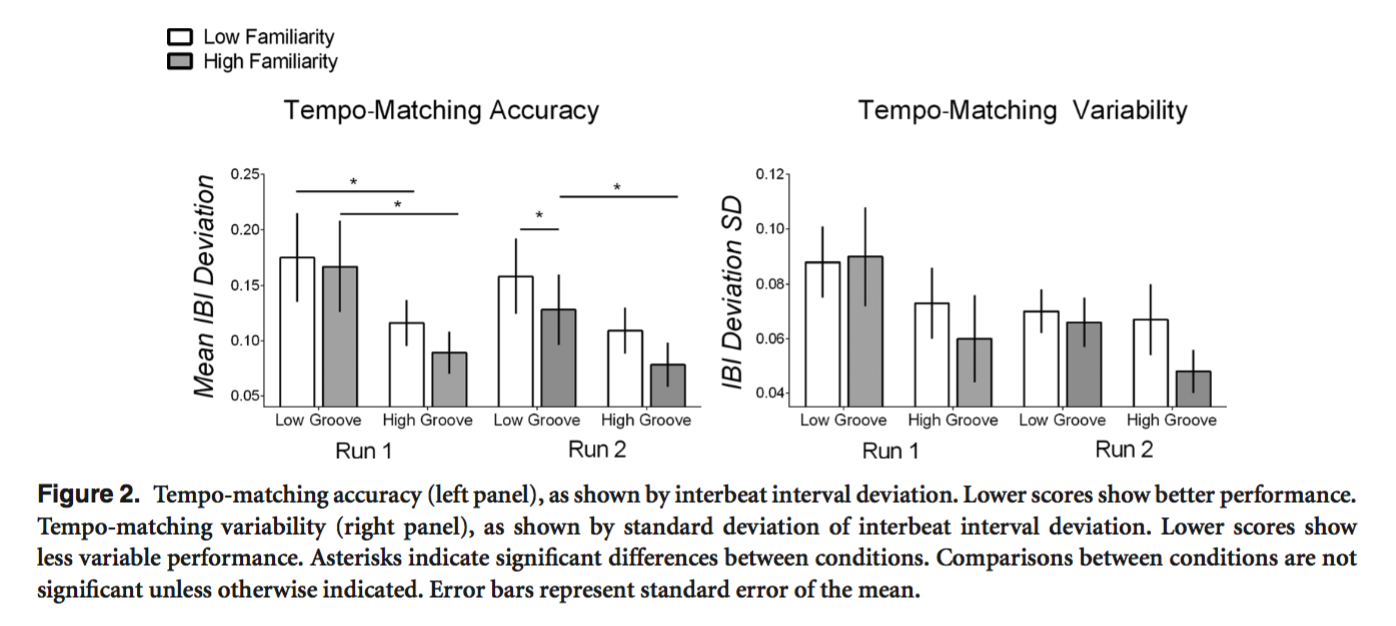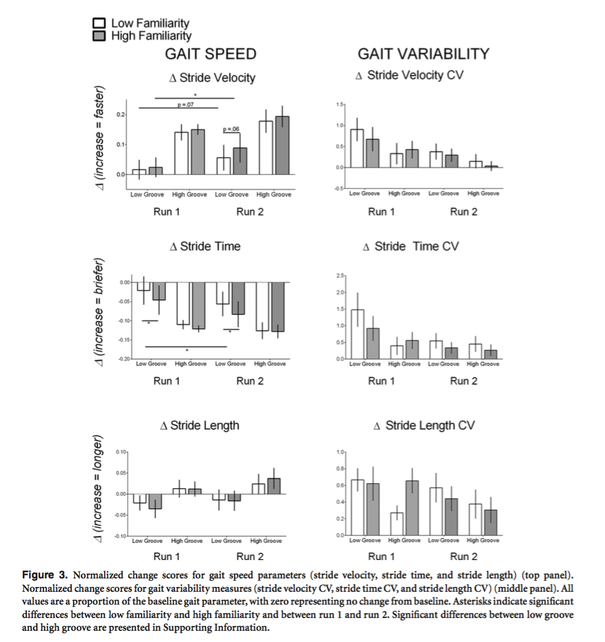Familiarity with music increases walking speed in rhythmic auditory cuing
In this study synchronization performance and gait parameters were assessed as healthy young adults synchronized to music that varied in familiarity and groove.
Click here to read the full paper.
Click here to read the full paper.
Background
Gait rehabilitation, synchronization of movements to a metronome or to musical beats, can partially improve gait abnormalities in Parkinson’s disease and stroke patients. This method is known as rhythmic auditory stimulation (RAS) but the outcomes of previous studies have varied, in part because of inconsistencies in the music used. In this study, we focused on two properties of the music, groove and familiarity, influence gait.
Familiarity, how much an individual knows the music, may reduce the cognitive demands of synchronizing movement. If the participant knows the song it may be easier for him or her to predict how to move their steps along with the music. Also, familiarity might lead to greater enjoyment of RAS. Repeated exposure to unfamiliar music increases music-induced pleasure or reward and at the same time increases movement “vigor” (people make faster movements in the context of reward). The reward induced by highly familiar music might elicit faster strides than that for unfamiliar music.
Groove is the property of the music that makes an individual want to move along with it. Participants rate songs with high groove as inducing more movement than songs with low groove. In the context of RAS, high groove music may elicit faster strides than low groove music.
In this study, we examined how familiarity and groove affected synchronisation and spatiotemporal gait parameters when walking to music. Participants synchronized to music that they rated as low or high familiarity, and unfamiliar music where familiarity was increased via repeated exposure during the experiment.
Familiarity, how much an individual knows the music, may reduce the cognitive demands of synchronizing movement. If the participant knows the song it may be easier for him or her to predict how to move their steps along with the music. Also, familiarity might lead to greater enjoyment of RAS. Repeated exposure to unfamiliar music increases music-induced pleasure or reward and at the same time increases movement “vigor” (people make faster movements in the context of reward). The reward induced by highly familiar music might elicit faster strides than that for unfamiliar music.
Groove is the property of the music that makes an individual want to move along with it. Participants rate songs with high groove as inducing more movement than songs with low groove. In the context of RAS, high groove music may elicit faster strides than low groove music.
In this study, we examined how familiarity and groove affected synchronisation and spatiotemporal gait parameters when walking to music. Participants synchronized to music that they rated as low or high familiarity, and unfamiliar music where familiarity was increased via repeated exposure during the experiment.
Procedure
Seventeen participants of the University of Western Ontario performed the following tasks:
Rating task
Each participant rated 26 music clips regarding
Cued walking run 1
Ten walking trials of the following conditions randomized (two per condition)
Repeated exposure task to increase familiarity
Participants were exposed to two repetitions of 1min clips of song selected for the first walking task, during each repetition they rated the songs on
Cued walking run 2
Participants completed another 10 walking trials with the same conditions of stimuli as in run 1, in random order.
Rating task
Each participant rated 26 music clips regarding
- Familiarity
- Groove
- Enjoyment
- Beat salience
Cued walking run 1
Ten walking trials of the following conditions randomized (two per condition)
- Low familiarity, low groove
- Low familiarity, high groove
- High familiarity, low groove
- High familiarity, high groove
Repeated exposure task to increase familiarity
Participants were exposed to two repetitions of 1min clips of song selected for the first walking task, during each repetition they rated the songs on
- Pleasantness
- Enjoyment
- Arousal (how relaxing or stimulating)
- Familiarity
Cued walking run 2
Participants completed another 10 walking trials with the same conditions of stimuli as in run 1, in random order.
Results
Familiarity effects
Familiar music elicited better tempo-matching (ability to match step tempo to stimulus tempo) accuracy overall, and it did not affect tempo-matching variability. High familiarity also elicited briefer stride times (the time of one step of the participant before doing the next step).
Familiar music elicited better tempo-matching (ability to match step tempo to stimulus tempo) accuracy overall, and it did not affect tempo-matching variability. High familiarity also elicited briefer stride times (the time of one step of the participant before doing the next step).
Repeated exposure effects
Repeated exposure reduces tempo-matching variability, it also resulted in faster and briefer strides, and reduced the variability of the gait (strides overall).
Groove effects
High groove elicited faster, briefer, and longer strides than low-groove music.
Repeated exposure reduces tempo-matching variability, it also resulted in faster and briefer strides, and reduced the variability of the gait (strides overall).
Groove effects
High groove elicited faster, briefer, and longer strides than low-groove music.
Conclusion
Greater familiarity with the music elicited more accurate tempo matching, suggesting that familiar music is easier to synchronize to. Familiarity with the beat structure of a song precludes the need to predict beat onsets as they unfold, reducing cognitive demands, which may lead to faster and less variable strides. Familiarity also increases enjoyment (music enjoyment elicits dopamine release) which is associated with greater movement vigour (faster movement).
Groove had greater effects than familiarity for stride velocity and time. Familiarity and groove can maximize gait speed in RAS protocols. Practice improves synchronization and reduces cognitive demand, facilitating faster and less variable strides.
Familiarity and groove of music are important to consider in future RAS implementations.
Groove had greater effects than familiarity for stride velocity and time. Familiarity and groove can maximize gait speed in RAS protocols. Practice improves synchronization and reduces cognitive demand, facilitating faster and less variable strides.
Familiarity and groove of music are important to consider in future RAS implementations.


